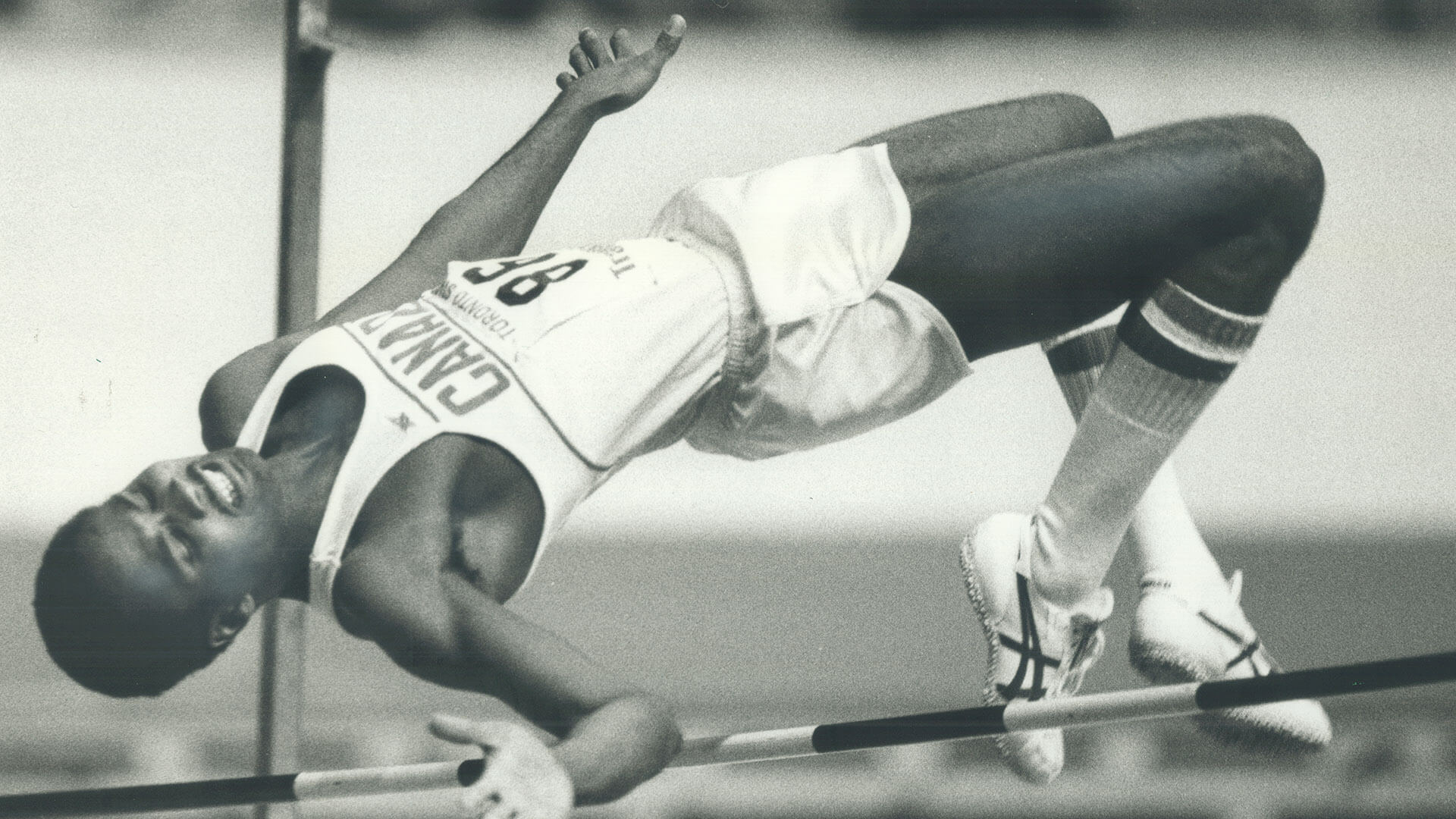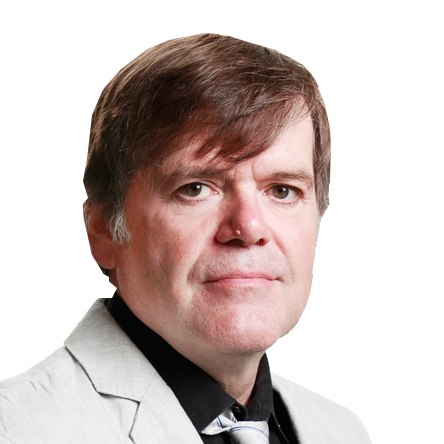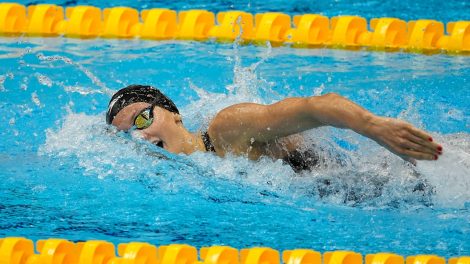Scarborough’s Milt Ottey soared like no other track athlete in 1982. He went undefeated in the high jump through the outdoor season. Competing for the University of Texas-El Paso, he won the NCAA track and field championships, but that was just as tune-up for the Commonwealth Games. In Brisbane, he cleared 2.31 metres, a world’s-best mark for the year.
In later seasons, however, Ottey struggled with injuries, including a broken leg, rotator-cuff surgery and back woes. Nonetheless, he successfully defended his Commonwealth title in ’86 and took home a bronze four years later.
When he cleared a personal best of 2.33 in Ottawa in 1986, he set a national record that would stand for the better part of three decades — 2016 Olympic gold medalist Derek Drouin is the only Canadian to post a better mark.
Ottey was inducted into the Athletics Canada Hall of Fame in 2012. These days, the 59-year-old owns and operates OT Fitness, a company that runs health and wellness programs for school-age kids.
Sportsnet: How did your family end up coming from Jamaica to Canada?
Milt Ottey: My mom came up from Jamaica when I was around seven years old. She was here for three years with my uncle and my sister, and then brought me up. She just wanted a better life for her children — it’s that simple. She wanted to have opportunities that we wouldn’t have had if we had stayed there.
[relatedlinks]
How did you get your start in track?
It was a total accident. At Dallington Public School, there was a line-up for high jump after school. I didn’t realize that it was a tryout for the school team, [but] I cleared the bar and made the team. After that, at the area meet, I did lousy. I didn’t know what I was doing. It was in middle school that I started doing it again, but not with any real training or coaching. I wound up doing six feet — I was ecstatic with that, but really I didn’t think I was going anywhere in the sport.
When you did get serious about competing?
Things came together so quickly. When I entered my first high-school meet, I was at Sir William Osler High School, a vocational school. The vocational schools didn’t compete in the main high-school sports events — they only competed with other vocational schools. The first time I entered the Toronto district championships was 1978, and it was a fluke. I was doing so well jumping for the vocational school that a teacher there put me into the Scarborough [meet] and I qualified for the Ontario championships and placed something like 15th.
After that I started to take it seriously. The following year [1979] I transferred to a regular secondary school and I joined the Scarborough Optimist Track Club. I wound up being the top high-school high jumper in Canada and made the national team that went to a few events, including the Pan Ams. I got the bronze at the Pan Ams and I still had a year left of high school.
We’re used to seeing tall high jumpers like Derek Drouin, who won the gold at the Olympics for Canada in 2016. Drouin’s six-foot-five. Were you the shortest international high jumper back in the ’70s and ’80s?
When I won the bronze in the Pan Ams I was five-foot-nine. I was shorter than almost everybody — the only high jumper shorter than me was [American] Franklin Jacobs, who I met when I was starting out. He was five-eight, maybe a half-inch taller. People would be in awe when they saw the short man jumping so high over his own height. It was like watching Spud Webb dunk.
In the ’80s, though, people really started tracking it… the idea that you were jumping a foot and a half over your head. I was in against jumpers who were six-foot-six and six-foot-seven, but Franklin and I didn’t care about how tall they were — we just went out there and jumped. They had to clear the bar just like us. [Being shorter] meant that I had to be technically sound, technically better than everyone. [American Olympic bronze medallist from 1976 and former world No. 1] Dwight Stones talked about being a technician, but he made loads of mistakes that he could get away with. I had to be better.
What was the high-school track-and-field scene like in Toronto back in the late ’70s? How does it compare to what’s out there today?
I don’t think the Canadian track scene has been as good as it was in the ’70s, early ’80s. The high-school athletes coming out of Toronto were the national track team — Ben Johnson, Desai Williams, Mark McKoy. It was just a different time. Track had such a big profile with all kinds of major events. You had the Maple Leaf Indoor Games [in Toronto], big international meets in Hamilton and Ottawa, meets all across North America every weekend from Dec. 29 to the spring.
Things started to change in ’84 with Ben [Johnson] and Carl Lewis. They were the draw, but how do you fill six lanes when one guy wants $100,000? Organizers just couldn’t put meets together, and they died off one by one. Now, there might be the Millrose Games in New York but that’d be it, and even it’s dying.
What would life have looked like for you if you hadn’t pursued a track career?
I would have missed out on so much. Growing up in a slow-learners or vocational system, there really wasn’t much hope. I know my mother was worried sick about me. I didn’t know what I wanted to do. I was actually thinking of joining the army after graduating from vocational school.
What could I do if I had stayed in the vocational system? College? There was no college for kids from vocational schools. And for me, even when my track and field was blossoming, I didn’t know the future that lied with it. At the time, back in the late ’70s, no one really knew anything about getting scholarships in the U.S. For you to do it was rarity. High schools didn’t know the procedures.
You wound up going to the University of Texas-El Paso, the alma mater of Greg Joy, the Canadian who took the silver at the Montreal Olympics in ’76. Were you following his lead?
I ended up at UTEP strictly by accident, really. The coach who had been recruiting me to go to California-Berkeley in my last year of high school moved to UTEP. They had a really strong team [in El Paso], but more than anything I felt like I had to go out on my own and grow up.
A lot of my friends from the Scarborough Optimists — Desai, Mark, Tony Sharpe — all went to Clemson. It wound up that Charmaine Crooks went to UTEP [on a track scholarship] at the same time, but we didn’t realize it until we were at the airport and bumped into each other. It turned out we were on the same flight.
You would have been a medal contender at the 1980 Olympics in Moscow, but Canada joined the U.S. boycott of the Games because of the Soviets invading Afghanistan. What was it like to be on the sidelines, missing out on those Olympics?
It was a disappointment for me, sure, but it didn’t affect me the way that it did veteran athletes on the Olympic team. Diane Jones-Konihowski, for instance, had been the world’s No. 1 pentathlete, and she and others were pointing to Moscow. They were pissed — completely understandable. I was just 20, though. It didn’t hit me as hard. I knew I had another Olympics in four years and other things — the Commonwealth Games, the Worlds — down the line. Did I understand the politics? No. Most of us didn’t. Did I feel cheated? Yeah. We were sacrificial lambs.
It was hard to accept that we had to sit out the Moscow Olympics and meanwhile [the NHL] had signed a deal to play the Soviets in hockey — how does that work if one country is boycotting another on principle?










